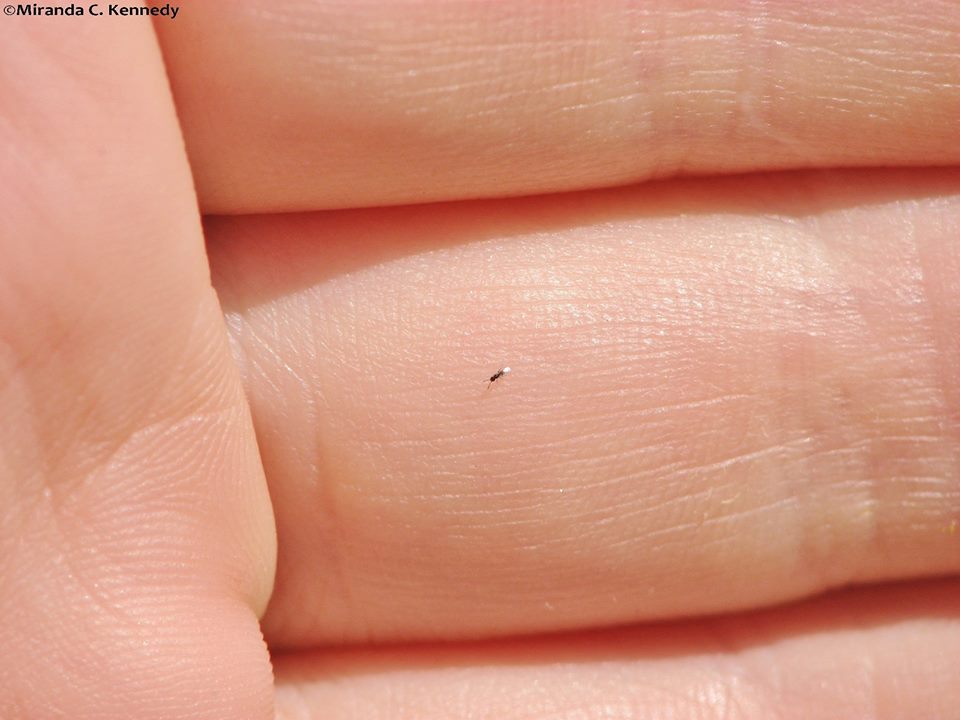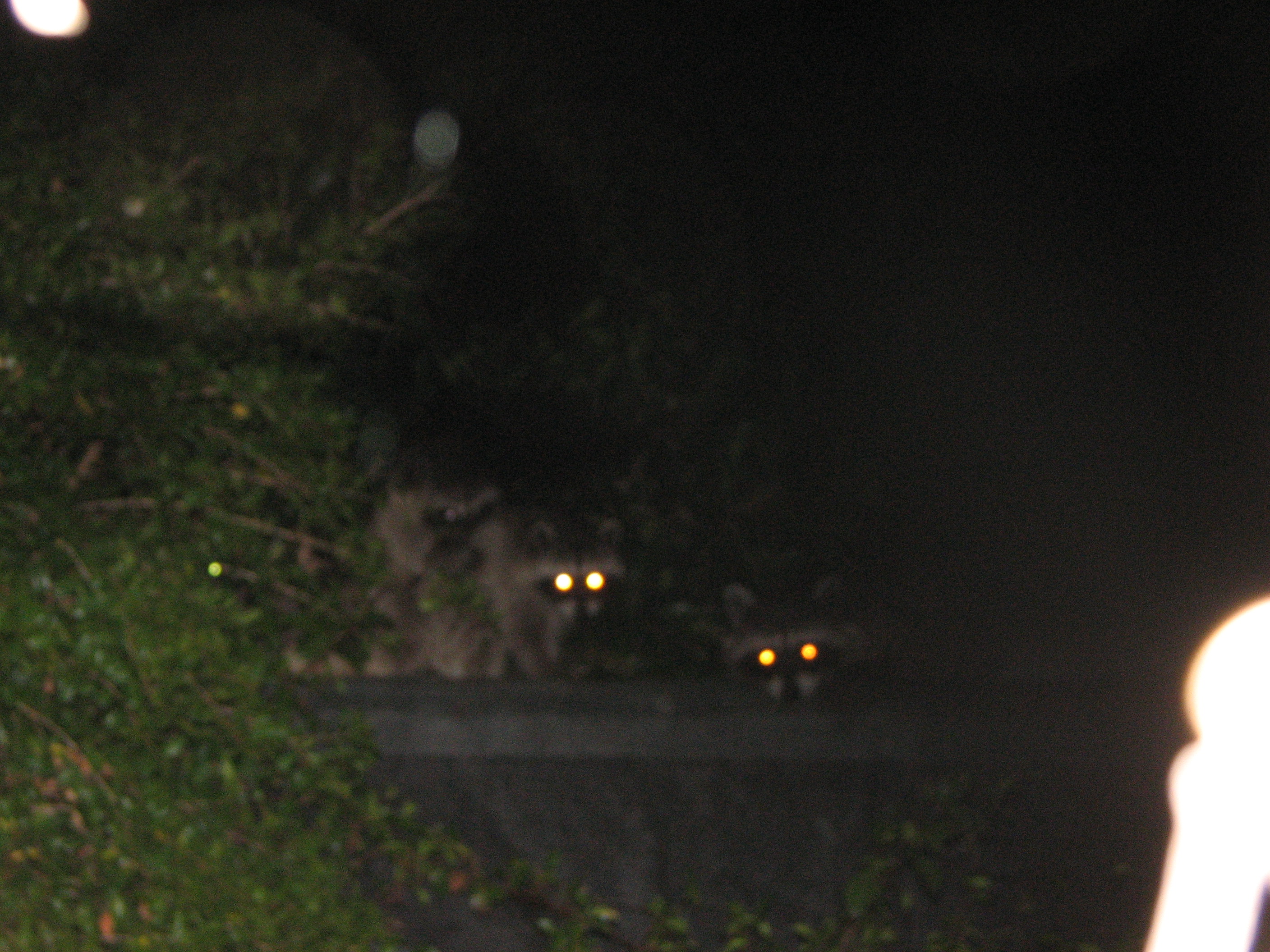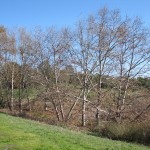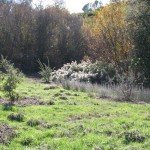Gardening adventures
Wrestling with the great outdoors.
-
Happy New Year
As my first post of 2012, I’ll make it a short one. I so appreciate your readership of this helter-skelter blog, and I hope that some of the posts have entertained and/or been helpful to you. I truly wish that all of you have a healthy, peaceful and fulfilling 2012.
-
Why Your House is Cold
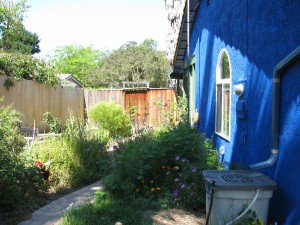
Blue southern wall with window. A friend from China told me that the rule of housebuilding was, “Sit north, face south.” In most areas of China, houses are situated so that the front long wall is facing south, with the short ends facing east and west. She went on to say that when she came to the US she had the hardest time finding her way around because the houses were placed every which way; very confusing.
What would be the reason for placing your house so that it faces south? The sun in winter, rotating lower in the sky, will warm the long portion of your home, the sun shining in your windows brightening the interior and, if you have thought ahead, will warm thermal mass such as a stone floor. In the summer, the sun will be overhead and slightly north. Your roof overhang will protect the house from most of the overhead sun, and when those late afternoon scorching rays hit the west side of the house, it will only affect a narrower wall. Planting trees or trellised vines on that side of the house will further protect from the heat. There is a fifteen-degree difference higher and lower between a house situated north to south as one situated east to west. That is a significant difference in energy savings: it means the difference between turning on the heater or just wearing a heavy sweater, or turning on the air conditioner or opening windows and using a fan.
So, you might wonder, how is my house situated? The wrong way, of course. If I had known about permaculture when I was looking for a house in which to raise my children thirteen years ago, I would have considered the way the house sits on the property and perhaps would not have moved here. Be that as it may, I have made many costly improvements on the house in the last few years, most of which deal with heating and cooling issues. The narrowest wall of the house faces south, and didn’t even have a window in it. The white stucco reflected light so brightly in the summer that it baked the plants in the garden and was impossible to look at without making my eyes water. The summer sun from noon on has been the worst. The western side of the house has three rooms with sliding glass doors (although no view except the yard) and the house bakes in the summer. The heat rises upstairs (it is a split-level) to the bedrooms and into the attic where it sits, making sleeping a challenge in the heat. In the winter, the few hours of weak afternoon sunshine doesn’t warm the house enough, but if those sliding doors were facing south instead, the house could be so much warmer all day. I don’t have and don’t want air conditioning, and don’t like using the propane-fueled forced air heating. There are two fireplaces, both small and in areas where most of the heat goes up the chimney and out the side walls.
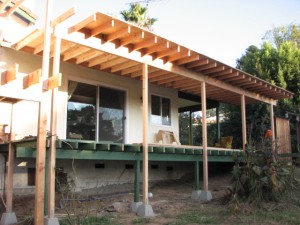
Part of the western side of the house (the rotten porch and overhang was rebuilt) What I’ve done is to replace the windows with energy-efficient glass. That helps, but it also insulates, so a cold house stays cold and a warm house stays hot. If the house had been built facing south, I probably wouldn’t have had to replace the windows at all, but just resealed them. I also painted that glaring southern wall a Mediterranean blue, which I find pleasing and helps keep the plants from cooking. It also helps absorb the heat in the winter. I installed a window on the south side, too, because there are gardens on that side. That helps brighten that room and allows in air and warmth. Thermal curtains are on every window, but I really hate closing them; I like to have the windows uncovered all the time (no really close neighbors). I have to pull them during the hot afternoons and during the cold evenings. I also have pull-down shades on the western porch to block out direct sun before it hits the windows. I installed a whole-house fan, which when turned on sounds as if a helicopter was landing on the roof. How it works is during a heat spell, when there is cool air coming in during the evening you open those doors, close the windows and doors upstairs, and the fan sucks the cold air into the house forcing it through the attic and outside through the air vents. The house cools down inside, the hot air in the attic is replaced by cooler air, and all the cats magically find hiding places you’ll never know about.
One fireplace now has a small wood-burning stove, which does throw more heat into the library but also only takes wood no longer than a foot, which is awkward since most firewood is longer. The other fireplace now has a Grate Wall of Fire http://www.gratewalloffire.com, which is an expensive grate and iron backing which positions the wood so that the embers deliver the heat out into the room rather than up the chimney. I absolutely love this product, and it was worth every penny. It makes lighting a fire easy, safe (the wood doesn’t roll into the room) and worth the effort.
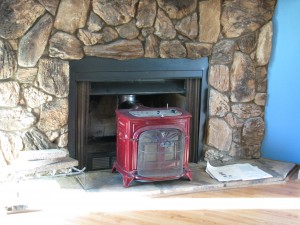
Wood burning stove is cute, but takes tiny logs. My big garage door faces east and is below the bedrooms. During the summer the morning sun hits that door and brings the temperature of the garage to a boiling point, and all that hot air rises to the bedrooms. I’ve put insulation between the support beams of the door and covered it with light plywood. The door won’t open automatically without a helping shoulder (I rarely open it anyway), but that insulation has made a tremendous difference in the temperature.
The house was always very dark inside. During the day I’d have to turn lights on to see. The overhang blocked a lot of sun, but was necessary to.. uh.. block a lot of sun. I installed Solatubes (http://www.solatube.com/) in the upper bathroom, living room, library, kitchen and in my daughter’s room which has no outside windows. What a difference! So much light comes into the house that I can even read without turning on a lamp in the daytime; we still make the mistake of thinking a light is on in the bathroom when it is just the Solatube reflecting out light. They have completely changed the character and feeling of the house to one of brightness and cheer.
The west side of the house is the tallest, where the yard is at level with a crawl-space under the house. When I moved in two huge pine trees blocked the western sun. Of course, within months they contracted a blight and died, and I had to cut them down (that is another story which involves a ladder, a handsaw, a rope, a breeze, and a lucky jump). I’ve replanted a tree which is slowly growing large enough to make a difference to the upper story, but it will also block the main view from the house of my much-improved gardens. Sigh.
If American houses were situated on lots so that they sat north and faced south, the savings in energy consumption from heating and cooling, the consumer savings in purchasing air conditioners, energy-efficient glass, insulation(view here for expert advice), lights, and the high labor costs of contractors would be tremendous. The personal comfort level of the inhabitants would be so much greater than there would be fewer fights and a healthier, more loving and peaceful atmosphere inside. Even with all the expensive changes I’ve made, the house is still hot in the summer and cold in the winter. If only I could pick the whole thing up and turn it forty-five degrees east. I love my house, but energy-efficiency shouldn’t be such a battle.
If you are looking for a house, building a house, or trying to find out why your energy bill is crazy high, take a good look at house placement. Permaculture isn’t just about planting plants, it is about sustainable and natural living.
-
December in Fallbrook
Coots on the pond Sunlight in the sleeping willows. Tranquility (try not to look at the houses). Tough and determined roots being fed by decaying golden leaves. An impromptu Christmas tree: a snag decorated with juniper, cranberries and bird seed. Lush green weeds keeping a low profile in the winter. Stately sycamores; their leaves shed to keep their roots warm. A season of greens, golds and blues. Coyote bush seed fluff glowing white instead of snow. -
Dragonfruit

Small ripening dragonfruit Dragonfruit have to have the most incredibly sensational color of any fruit. Their blooms are wild, showy and no better than they ought to be, and the fruit has colors so loud they bedazzle the eyes. Also known as pitaya or pitahaya, dragonfruit grow on either columnar or vining cactus plants. Their history is recorded with the Aztecs, and now they are grown in Vietnam and parts of Malaysia. Due to their soft texture, the fruit isn’t conducive to shipping and handling, so finding them at Asian marketplaces or Farmers’ Markets would be your best bet. However, the popularity of this plant is catching on and since they take up little room, can be grown at home.

There, amongst the proper cosmos, a wild flaunting beauty! I have two vining dragonfruit, which I’ve propped up on the trunks of two Washingtonia palm trees for support. They receive sun there, but some protection from the intense late afternoon sun, and it is a frost-free area. One morning in late summer I went out among the small cosmos and other English-style flowers of that yard, and suddenly noticed this enormous tropical flower looking so out of place. It was gorgeous, fragrant, and sultry next to the prim annuals. The flower of the dragonfruit has a nocturnal bloom, relying on bats and moths for pollination; apparently even those that are self-fertile, as this one evidently is, needs some interaction with bats and moths to set fruit. To insure pollination, growers will make an evening event of hand-pollinating, paint brushes and flashlights in hand. The flower slowly faded during the day and was limp in late afternoon; I’m glad I was lucky enough to see it in the morning at its most sensual state.

This gorgeous, fragrant flower was as large as my face. I didn’t think that the flower would set fruit, but the plant surprised me again when I glanced over last week and saw a red dragonfruit. This particular dragonfruit has red skin and crimson flesh. Some have red skin and white flesh, or yellow skin and white flesh. The most dramatic I’ve seen was a bright green skinned fruit with crimson flesh! All have small black seeds inside.

Hey, there's a dragonfruit! Dragonfruit is famed where it grows for its health benefits which are extensive, as well as the fiber and vitamins it contains. Dried dragonfruit is supposed to be more potent than fresh in some ways, and is a better eating alternative for those who don’t care for the texture of the fresh fruit. A good website honoring the nutrition aspect of dragonfruit is http://dragon-fruit.biz/ .

Red on the outside and crimson in the middle Propagation can be done by seed, which is slow, or by one-foot-long cuttings from fruit-bearing plants. Allow the cuttings to harden off before planting, just as you would any cactus or succulent. Plants will need support, especially the vining kind. They are tropical plants, so enjoy warm weather, regular watering without standing in water, and some humidity.
For sheer spectacular showiness, you can’t beat the neon colors of dragonfruit. Eat out-of-hand, in fruit salads, blend in smoothies or for sherbets, or dry to slightly chewy bits that are packed with nutrition. You will certainly impress your neighbors; in fact, invite them over for an evening pollination party! That ought to get the homeowner’s association all worked up!
-
Subversive Gardening

Veggies I’m going to cheat on original material in this link, and urge you to watch Roger Doiron (of Kitchen Gardeners International) talk about the gardening revolution. The important points are about the famine, obesity and monoculture problems and how we can save ourselves with backyard gardening… no different a message than Geoff Lawton’s, who says that all the world’s problems can be solved in a garden. The Doiron video is entertaining as well as informative, so please take a few minutes to watch it. I found it on a link from Treehugger.com, which has today several good articles about the Occupy movement, having a beehive, making a rocket stove and a wedding dress made of rubber gloves! Scroll down this link to watch the Doiron video here: http://us.mg201.mail.yahoo.com/dc/launch?.partner=sbc&.gx=1&.rand=7do57p67k7bh0 .
-
Rain
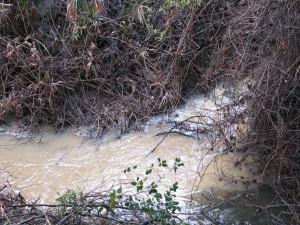
Runoff An interesting fact, especially for those of us in low-rain areas: An inch of pH neutral, nutrient-freeing, perfect rain falling on one acre of land is the equivelent of 27,154 gallons of water. Yep. Where does it go? For most people, it runs off into the storm drains and eventually to the ocean where it becomes salty and unusable without treatment. Then a couple of weeks later, on come the sprinklers delivering not-so-good quality expensive domestic water, further locking up the nutrients and killing the microbes in the soil. How can you capture that wonderful resource of natural rainwater? Water barrels are alittle help, but mostly what you need to do is shape your soil to catch the runoff. Swales, deep loam, and strategic planting can quickly take all that water… even the amount that pours off of your roof, and capture it in the soil. The water slowly sinks and moves the way it was going before, but without taking the topsoil with it. As it moves, the plant roots absorb it over a long period of time, along with all the nutrients that pH-neutral rainwater has freed up in the soil. Your landscape will be stunning, your water bill can eventually be reduced to zero, and if you grow food plants, the nutrition level in them will rise. Here is a video from permaculturalist Geoff Lawton with graphics: http://www.youtube.com/watch?v=UFeylOa_S4c.
This is the essence of permaculture. Simple, logical effort to use what we already have to return the soil to the sponge it was before we compacted it. So how large is your plot of land? Nine acres? A back porch with pots? You can still do the math and see how much water you can capture. Look up rainwater harvesting videos on YouTube and see plots of land in the desert that harvest rainwater and are oasises of food, habitat and beauty, without supplemental water. Here is what Lawton has done with ten acres in Jordan: http://www.youtube.com/watch?v=xvmx4lcqQVw. If they can do it on that scale in that poor an area, any homeowner can do it.
- Chickens, Gardening adventures, Humor, Permaculture and Edible Forest Gardening Adventures, Vegan, Vegetables, Vegetarian
Planting Easter Dinner (in November)
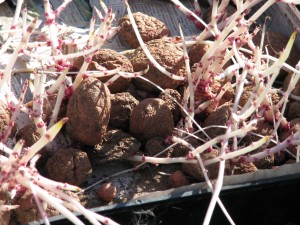
Creepy white fingers I finally was able to work in the vegetable garden today; me and my helpers, that is.
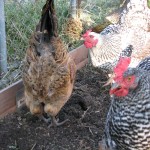
Kakapo, Miss Amelia and Lark, helping I am by no means done, but I did some major cleaning out of old veggies. Out went the tomatoes that aren’t producing, dead squash vines, weeds, a volunteer avocado tree and the two enormous zucchini plants which, although having been cut in half, abused and ignored, have still been putting on a squash a week. I have one more zuke plant left, but these big guys had to go. The compost heap is… well… a big heap.
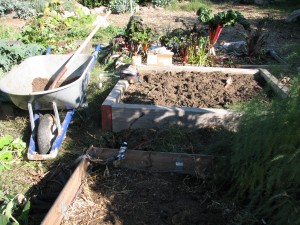
White potatoes in the closest bed, root veggies and brassica seeds in the back one As I study Permaculture, I’m more aware of the millions of microbes in the soil and the fine network of fungus that enriches plant roots. The less I disturb my garden soil, the better. After pulling the weeds, I sprinkled on GardenAlive’s soil enhancer, which are more microbes, as well as their organic Roots Alive fertilizer. I used a trowel to lightly work it all just under the soil surface, then topped it with compost from my compost bin. Having soil that is healthy, rich smelling and alive is any gardener’s dream. All those microbes free up nutrients in the soil so that your plants can suck them up and use them, which makes your veggies not only healthy and more resistant to bugs and diseases, but produce … um…. produce that is loaded with vitamins and minerals. Its like the old gardener’s joke: A gardener asks a man what he puts on his strawberries, and the man answers, “Cream.” The gardener shakes his head in disbelief and says, “I always put manure on mine.”
Potatoes from spring, which I’d stored in a dark cabinet under the house, decided they didn’t want to wait any longer.

Eager potatoes Fall is a good time to plant potatoes, as long as you keep their greenery protected from frost. Since potatoes can be grown from cuttings (as well as tubers and seeds), and to produce more potatoes you slowly mound up compost or straw around the stem as it grows, I tried something with these long white fingers. I lay each potato on the soil, with the long white stem laying flat, and covered them all up with light mushroom compost.
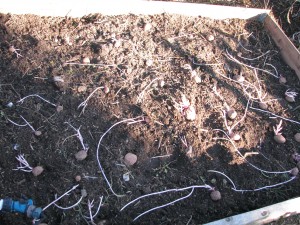
Laying down the potato stems to form new plants I’m betting that the stems will all take root and send up greenery along the nodes, using phototropism. That will multiply the number of potato plants by a lot. Then as the greenery grows, I’ll add more straw and compost around them. If all works out, sometime early next year I should be Potato Queen of Fallbrook! Of course, I had lots of help with the project.
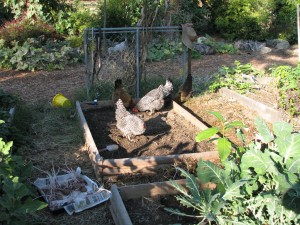
Lots of helpers. I fenced off the beds after I planted A few months ago I planted pieces of yam that had started to grow in the house. The vines flourished outside of the bed. Now that I’ve cleared the massive zucchinis out of the way, I’ve pulled the vines back into the bed, layed them out so that they (mostly) touch the soil, and have dumped mushroom compost on parts of them. The object is to allow them to root along the vines and make more yams. I’ll let you know if this works or not.

Taming the yams I’m also planting carrots and parsnips. The ‘nips won’t be ready until next spring, having improved in flavor for any frost we may receive. I’m hoping there may be some small carrots ready for Christmas dinner, but I really should have put them in last month to be sure. In will go the brassicas: Brussels sprouts (did you ever wonder if it smells cabbagy in Brussels?), broccoli and cauliflower. These guys all like a good chill, as long as they are protected from frost. More cool-weather lettuces will go in, as well as lots of endive for my tortoise. Onion sets and seeds can go in, as well as radishes. The arugula has reseeded itself again and is coming up in all the pathways, with even an elegant specimen right next to the large pond by the rushes!
You remember the pond, which was put in to attract wildlife, right?

Wildlife gathers at the watering hole.... I still have tomatoes and eggplants producing. I tied up the lazy ferny stalks of my first-year asparagus to get them out of the way. The horseradish plant seems to be doing well; I have to consider what to serve it with at Christmas. My dad loved horseradish sauce, as do I, and I grow it as a memory of him and our Polish heritage on his side. I used to make him his favorite soup, borscht, but I would never taste it because I just don’t like beets.
Tomorrow, if I can move my joints after many days of weeding, I’ll clear out the remaining ’empty’ bed and cover the unused ones with compost and straw to sit until spring. I am so glad that I can garden almost year-round!
- Bees, Chickens, Gardening adventures, Other Insects, Permaculture and Edible Forest Gardening Adventures, Vegetables
Crazy-Pot Seeds
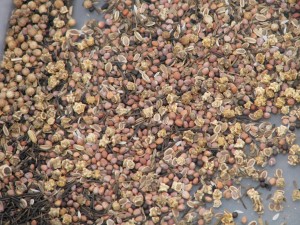
Crazy-pot mixture of veg seeds Today, the palindromic 11/11/11, was also Veteren’s Day and a day between two rainy weekends. A perfect day for spreading lots of seeds. With winter rains on their way in a month, it is important to hold the topsoil with rooted plants, and why not use a cover crop that also fixes nitrogen? My choices were hairy vetch and a tall native lupine.
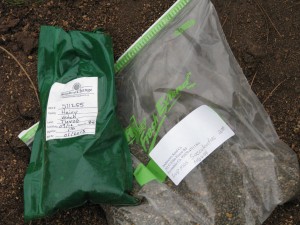
Native lupine and hairy vetch seeds I would also have liked to use white or sweet clover but sources were sold out early this year. Both my choices will have flowers that offer plenty of nectar to bees, be lovely, hold the soil, set nitrogen, and can be, if needed, sacrificed. When you ‘sacrifice’ a nitrogen-fixer, you can either turn it under or cut the tops, leaving them in place on the soil surface to decompose.

Plant guild waiting for seeds I don’t agree with disturbing my soil microbes any more than necessary, so I won’t be tilling ever again. When you cut a nitrogen-fixer, the roots release the nitrogen they hold into the soil as the tops mulch then decompose bringing lots of nutrition to the soil surface. Vetch should be a winter crop, and lupine a spring crop, if they can tell the difference here in San Diego!
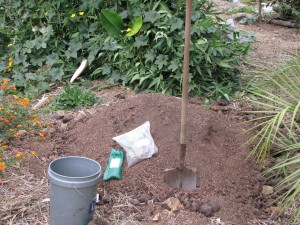
Mixing seeds with mushroom compost My method for spreading these two was to mix handfuls of each with a bucket of mushroom compost, and hand spread it in the most bare and most unfertile areas.

Broadcasting lupine and vetch seeds mixed with compost Adding the compost, I thought, helped the seed distribute more evenly, gave it a little cover since I wasn’t going to rake it in, and disguised it from birds a little.
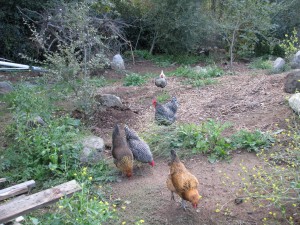
The girls. Once done, I decided it was also a good time to do something I had been looking forward to doing for years: spreading old veggie seeds. I’d done a little of this in a raised veggie bed, with some success. I have so many old packets of veggie seeds that I’m not going to use in the raised beds (I have all organic seed now), and I can’t believe that it isn’t viable. If they sprout seeds found in ancient Egyptian tombs, then I’m sure mine can sprout, too. This seeding is a very important step in the edible forest garden.
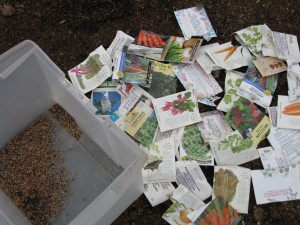
Many old winter crop seeds This year’s abundance of herbs, squash and tomatoes has been fabulous… I still have some ‘feral’ tomatoes putting on enormous fruit which I pick, polish and eat out of hand in the garden while I’m working.
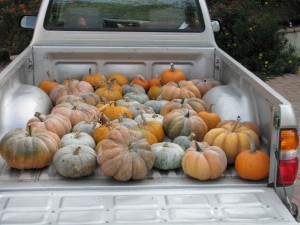
Pumpkins and squash on their way to the Fallbrook Food Pantry I opened all the packages of seed for cool-weather vegetables, such as carrots, radish, dill, broccoli rabe, and lettuces. Some such as garlic chives and onion I separated out and sprinkled near roses, since alliums are a companion plant for roses and help ward away aphids. The rest of it was mixed up in a lovely crazy-pot of seeds. I didn’t mix with compost this time, as there were fewer and smaller seeds involved. I sprinkled them then covered them with soil using my foot… the professional way to plant!
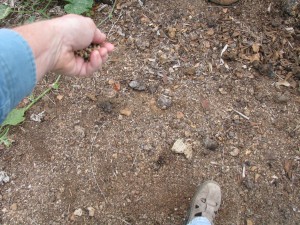
Scattering veggie seeds I am eager to see what comes up after the rain this weekend. It truely will be an edible landscape. Even if I allow the veggies to go to seed, the blooms will all be excellent bee food sources, especially the carrots and dill. None of these were nitrogen-fixers, because I used all the extra peas up in the vegetable beds this spring (see archives) improving the soil. Beans, and other warmer-weather seeds I’m holding back for February or March planting. I do have sweetpea seeds to plant out, but the lupine and vetch will be working their magic anyway.

Embankment with ragweed, now seeded with lupine and vetch 
Under the soil is now daffodil bulbs, lupines, vetch and mixed vegetable seeds About ten years ago I had a short story published in the young person’s magazine Cricket called Taking Tea with Aunt Kate. In it a girl lived with her mother who was a wild, messy gardener, spreading seeds all together and having veggies and flowers mingling in riots of color. The girl’s aunt is, by contrast, perfectly coiffed and takes her to a formal ‘high tea’ at a prestigious restaurant. The girl decides that she can be a little of each woman, a little wild and a little formal. I think I’m that child! I clean the dirt out from under my nails so that I can go to the opera.
I’ll be walking the garden in the next few weeks, waiting for tell-tale sprouts (and trying to figure out if they are weeds or not!), and watching the bare areas come to life. How fun!
-
The Little Guys in the Soil
I know, I know, I’ve been very delinquent. However I have been working hard, reading a lot and studying. I’m taking a Permaculture Design Course in San Diego on most weekends, and the information has been dazzling. Even though I know a little or a lot of what is being presented, what amazes me is how related the information is and how it all works together. For instance…
Gardeners know that the best pH for soil is somewhere around 6.5. Higher or lower than that and the soil has too much acid or alkaline. Here in San Diego we have alkaline soil. Rainwater is excellent because it has a neutral pH. What is so important about that neutral pH? Well, I’m going to tell you. There are all kinds of nutrient in the soil in the form of trace minerals, such as iron, magnesium, copper, etc. However these nutrients are bound up in the soil because of the pH… some are bound by a high pH, some by a low pH. For instance, we have adequate iron in our soil, but because of the alkalinity, plants can’t access it and become iron deficient. If you have neutral pH, then plants are able to feed themselves nutritiously. To free up the iron, you should add mature compost and water as much as you can with collected rainwater.
Okay, so you knew all that. So did I. Here comes what I think is the interesting thing.
We know that the soil is teeming with little beings such as bacteria, fungi and nematodes. Some are good, some are bad. Such is life. Picture if you will the soil in a forest, which has a lot of large materials such as logs and sticks being broken down by various fungus. The soil in a vegetable garden, however, is loamy with small particulate matter. Well, in a forest situation, with an acid soil, there is high fungus activity and lower bacteria count in the soil. The soil isn’t usually turned over or bothered in any way. In a vegetable garden, a slightly more alkaline soil is perfect because it has less fungus and more bacteria. The soil is turned over frequently. Weeds such as grasses prefer a pH range that is slightly more alkaline. By changing the pH with the addition of different kinds of mulch, you can moderate the microbes in the soil, tipping the balance between fungi and bacteria, and edging out the grasses. Cool, huh?
Fungus is extremely important where longer-lived trees are planted, because fungus travels underground, linking with the spreading roots of the trees and actually causing communication between them! Fungus, it has been said, is nature’s Internet. Mushrooms are called nature’s teeth, too, but that is an image that perhaps you just don’t want in your head. Bacteria help soil that is often disturbed by helping leguminous plants fix nitrogen (yes, yes, I know, back to the darn legumes again), and help free up nutrients for the roots, usually by dying. That’s not a happy thought but, again, that’s the way it goes. If you till the soil, you kill off the bacteria and nematodes and fungus and all the other little critters. There is a rise in fertility, but only briefly because that rise is the nutrition released by the decomposing bodies of all your soil critters! Then there is just dead soil. Then farmers pour on the salt-based fertilizers (NPK), which is just salting the land and making sure nothing can live in it. The crops grow, but since there aren’t any friendly critters freeing up nutrients, the resulting nutritional value of the produce is poor. Only by mulching, composting, and cover-cropping can the soil come alive again, which nourishes the plants, which nourish us.
There is so much life in just a pinch of soil; so much going on that we still can only guess at. To build up your soil with mulch, compost and organic practices is to give life to gajillions of life forms (yes, that many!) which all work to make your plants healthy, your food more nutritious, and gain back some of the topsoil that has disappeared through man’s blundering.
I hope this was as interesting for you as it is for me!
- Bees, Gardening adventures, Other Insects, Permaculture and Edible Forest Gardening Adventures, Vegetables
Nitrogen-Fixing Plants

Sweet pea If you’ve read my posts from this spring, you’ll have endured me going on and on about peas and beans and how they fix nitrogen in the soil. For those who nodded off during those episodes or who have just tuned in, I’ll go over it briefly.
Some plants have the ability to fix nitrogen in the soil. Actually, a type of bacteria called a rhizobia invades the roots of plants in the Fabacea family and a few others, and fixes atmospheric nitrogen in nodules on the plant’s roots. This is beneficial to both the plant and the bacteria, a process called mutulism. It also benefits whatever grows around the plants because, when the plant dies, the nodules release their nitrogen into the surrounding soil. In the case of long-lived shrubs and trees that fix nitrogen, as roots die off or are replaced, they release their nitrogen.
An edible forest garden is one where man mimicks the dynamics of an old-growth forest. Why? Because forests succeed without the aid of fertilizer, tilling, mulching, irrigation or any interference or ‘help’, as it were, from man. How does it do this? The plants that grow complement each other, providing what each other needs. These relationships are called plant guilds. You can create plant guilds, substituting plants that provide food for humans. In a guild there is a taller tree which provides shade and leaf droppings (mulch), shrubs which provide more shade, mulch and habitat for animals and insects, plants that fix nitrogen in the soil, plants that have long tap roots called ‘miner’ plants, because they take up nutrients from deep in the soil and deposit them on the soil surface when their leaves die off, plants that attract pollinators, and plants that are ground covers to regulate heat and moisture. Using permaculture practices for water harvesting and organic gardening, when the guild matures it should be almost completely self-sustaining.
Say you want to plant an apple tree. That would be your tall canopy tree for the guild, which drops leaves as mulch. Beneath it, you could plant a shrubby herb such as rosemary (another edible), daikon radishes (miners, leaving the cut leaves on the surface after harvesting the edible root), bush beans (legumes) and herbs such as dill, parsley and basil, some of which you allow to flower for pollinators. As the tree grows, the plant guild can widen and others planted.
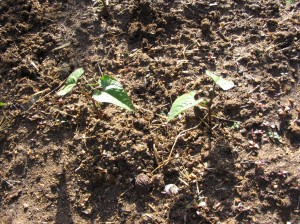
Beans There are many plants, trees and shrubs that fix nitrogen in the soil. All beans and peas including soybeans and fava beans do; when the plants are finished cut them above the soil so the roots stay put and decay where they are to release the nitrogen. Cover crops such as clover and hairy vetch are grown and turned under to improve the nitrogen in the soil. If you are from the Southern California area, perhaps you’d be interested in knowing what native plants are nitrogen fixers.

Ceanothus (California Lilac) at Elfin Forest The native Southern California nitrogen fixers include: ceanothus, lupine, deerweed, California peashrub (endangered) (lotus), and redbud. Non-natives that are commonly used are alders, acacias, calliandra, sweet peas, guaja, and many more, as the Fabacea family is very large. Use any of the natives in ornamental gardens and not only will you be improving the soil and the vigor of the surrounding plants, but providing much needed habitat for our native birds and insects.
Try building plant guilds; it is challenging and fun. Many combinations of plants are suggested on permaculture

